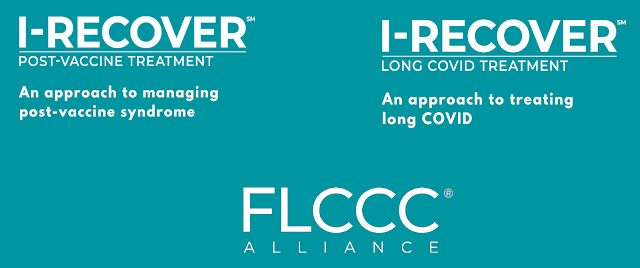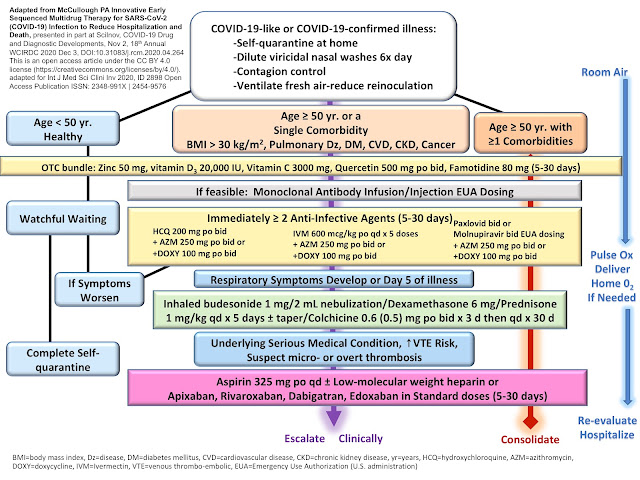Efficacy of Low-Cost Repurposed Drugs for COVID-19: A Systematic Review of Clinical, Preclinical, and Mechanistic Evidence (2025)
Abstract:
Low-cost systemic treatments, including ivermectin, hydroxychloroquine (HCQ), metformin, antiandrogens, antihistamine H1RAs, curcumin, melatonin, colchicine, probiotics, azvudine, N-acetylcysteine (NAC), fluvoxamine, nigella sativa, famotidine, and quercetin, demonstrate significant efficacy against SARS-CoV-2. This systematic review synthesizes evidence from 423 HCQ studies, 105 ivermectin studies, and numerous trials for other treatments, supported by in silico, in vitro, and animal studies. Early treatment and prophylaxis with HCQ show strong efficacy (p<0.0000000001)*, with the largest RCT reporting 57% lower symptomatic PCR+ COVID-19 (p=0.0002). Ivermectin exhibits efficacy across prophylaxis (96% lower high viral load cases), early, and late treatment (p<0.0000000001), with 36% lower long COVID risk (p<0.0001). Polytherapy enhances outcomes (68% [57-77%] risk reduction) compared to monotherapy (33% [30-36%]), driven by synergistic effects. Despite challenges like variable pharmacokinetics, bioavailability, and regulatory suppression, these treatments offer accessible options, particularly for early intervention, though their role in low-risk infections may be limited as SARS-CoV-2 evolves.*A p-value (a statistical measure) of less than 0.05 ( the typical threshold for significance in scientific papers) indicates statistical significance, while a value below 0.01 suggests high significance. Therefore, a p-value of less than 0.0000000001 implies extremely high significance, indicating a very strong likelihood that the tested treatment is proven or predicted to be effective.
Introduction:
The global burden of SARS-CoV-2 has necessitated the identification of affordable, effective treatments. This review evaluates low-cost systemic therapies, including ivermectin, hydroxychloroquine (HCQ), metformin, and others, focusing on their efficacy, mechanisms, and challenges. With extensive clinical and preclinical data, these treatments show promise, particularly for early intervention and prophylaxis, though their application must account for viral evolution, patient-specific factors, and regulatory barriers.
Methods:
Data were compiled from 423 HCQ studies (references 117-542), 105 ivermectin studies (references 11-115), and additional trials for metformin, antiandrogens, antihistamine H1RAs, curcumin, melatonin, colchicine, probiotics, azvudine, NAC, fluvoxamine, nigella sativa, famotidine, and quercetin (references 410-982), sourced from c19early.org and published literature as of April 06, 2025. Efficacy was assessed through meta-analyses, with risk reduction percentages and 95% confidence intervals for monotherapy (33% [30-36%]) and polytherapy (68% [57-77%]). Preclinical evidence included in silico, in vitro, and animal studies. Statistical significance was evaluated (e.g., p<0.0000000001 for HCQ and ivermectin). Web-based searches provided context on regulatory and manufacturing challenges.Keywords: Low-cost treatments, ivermectin, hydroxychloroquine, polytherapy, SARS-CoV-2, early treatment, prophylaxis, antiviral mechanisms, COVID-19.
Results:
- Hydroxychloroquine (HCQ): Analysis of 423 studies showed strong efficacy for early treatment (p<0.0000000001, 38 studies) and prophylaxis (p<0.0000000001, 118 studies), confirmed by meta-analyses (references 418, 1023-1030). The largest RCT (4,652 patients) reported 57% lower symptomatic PCR+ COVID-19 (p=0.0002) (reference 533). Preclinical studies (24 in vitro, 3 animal) support HCQ’s inhibition of endosomal acidification (references 996, 1009, 1020). However, 90% of studies focused on late treatment, showing poor results and potential harm with excessive dosing (references 1031, 1032). Selective reporting and termination of 102 RCTs suggest suppression of positive results (references 1034-1129).
- Ivermectin: Across 105 studies, ivermectin demonstrated efficacy (p<0.0000000001), with a prophylaxis RCT showing 96% lower high viral load cases (reference 115) and a long COVID RCT reporting 4x faster anosmia resolution (reference 89). The largest RCT showed faster recovery (probability >0.999) and 36% lower long COVID risk (p<0.0001) despite design biases (reference 96). Preclinical studies (25 in vitro, 14 animal) highlight ivermectin’s broad antiviral activity and mechanisms like spike-ACE2 disruption (references 1172, 1215).
- Metformin: Supported by 104 studies (references 415, 421, 544-645), metformin inhibits SARS-CoV-2 in vitro (references 551, 1248) and reduces lung damage in animal models (reference 627). Meta-analyses confirm efficacy (references 1254-1275).
- Other Treatments: Antiandrogens (49 studies), antihistamine H1RAs (17 studies), curcumin (27 studies), melatonin (18 studies), colchicine (56 studies), probiotics (28 studies), azvudine (33 studies), NAC (24 studies), fluvoxamine (21 studies), nigella sativa (14 studies), famotidine (30 studies), and quercetin (12 studies) all showed efficacy, supported by meta-analyses and preclinical data. Mechanisms include antiviral, anti-inflammatory, and immunomodulatory effects.
- Polytherapy: Combined treatments reduced risk by 68% [57-77%] versus 33% [30-36%] for monotherapy, with synergistic effects observed (e.g., ivermectin with niclosamide, reference 1178). Efficacy varied across SARS-CoV-2 variants, cell types, and genetic profiles (references 1470-1482).
Challenges include variable pharmacokinetics (e.g., HCQ lung concentrations, reference 1021; ivermectin inter-individual variability, reference 1236), bioavailability issues (e.g., curcumin, reference 1329), and counterfeit drugs (references 1133, 1242). Late treatment and excessive dosing often led to poor outcomes (e.g., HCQ, reference 1000).
Discussion:
Low-cost systemic treatments offer significant potential for COVID-19 management, particularly with early use and prophylaxis. HCQ and ivermectin demonstrate robust efficacy, supported by large RCTs and preclinical data, though late treatment and dosing errors reduce effectiveness. Other treatments like metformin and curcumin provide additional options, with mechanisms targeting viral entry, inflammation, and immune modulation. Polytherapy’s superior efficacy reflects complementary actions, addressing challenges posed by SARS-CoV-2 variants and genetic variability. However, systemic antivirals may be less effective for low-risk infections as the virus evolves (reference 1483). Regulatory suppression, selective reporting, and manufacturing inconsistencies (e.g., fake tablets, references 1133, 1242) hinder adoption. Limitations include biases in trial design (e.g., ivermectin RCTs, reference 1232) and the focus on late treatment in HCQ studies, which misaligns with optimal antiviral use.Conclusion:
Low-cost systemic treatments like ivermectin, HCQ, and others are effective against SARS-CoV-2, particularly with early intervention and polytherapy. Despite challenges, their affordability and accessibility make them valuable, though their role may diminish for low-risk infections. Future research should focus on optimizing formulations, addressing variability, and overcoming regulatory barriers to ensure equitable access.References:
Agarwal et al., Low dose hydroxychloroquine prophylaxis for COVID-19 - a prospective study, medRxiv,
Koskinen et al., Androgen deprivation and SARS-CoV-2 in men with prostate cancer, Annals of Oncology,
Therapeutic Goods Administration, TGA warns about imports of ivermectin, News Release, December 2021,
Kotani et al., Antiandrogen agents in COVID-19: a meta-analysis of randomized trials, Minerva Medica,
Bahun et al., Inhibition of the SARS-CoV-2 3CLpro main protease by plant polyphenols, Food Chemistry,
Chandran et al., Molecular docking analysis of quercetin with known CoVid-19 targets, Bioinformation,
.png)



.png)



Comments
Post a Comment